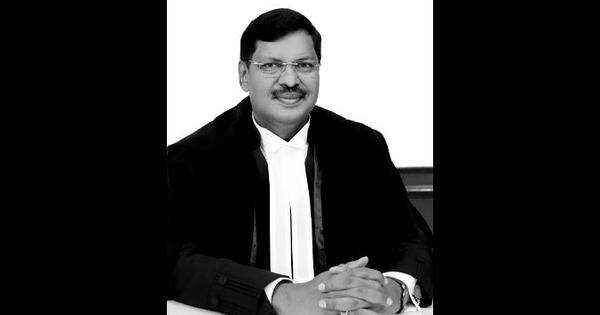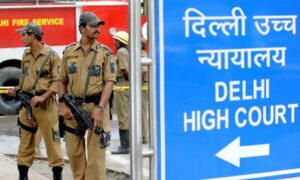
On Monday, an unprecedented act of courtroom aggression unfolded in the Supreme Court of India. A lawyer named Rakesh Kishore took off his shoe and hurled it towards Chief Justice of India BR Gavai, shouting, “Sanatan dharma ka apmaan, nahi sahega Hindustan.” India will not tolerate disrespect towards Sanatan Dharma (the term use as a synonym for Hinduism).
The provocation, ostensibly, was an observation by the chief justice while dismissing a petition seeking the “rehabilitation” of a Vishnu idol in one of the Khajuraho temples under the Archaeological Survey of India.
This was not an ordinary outburst. It was a violent assertion of majoritarian sentiment directed at a Dalit occupying the highest judicial office – an act that sought to discipline the judiciary itself, warning it not to transgress the sensitivities of the majority. It was, in essence, an act of symbolic terror: a public attempt to intimidate the constitutional guardian of justice in the language of religious nationalism.
Yet, nothing happened to the assailant. Though swiftly apprehended and removed from the courtroom, he was released without charges. Even his shoe was returned. The Supreme Court Registry reportedly refrained from initiating formal proceedings and police were instructed not to detain him.
The Bar Council of India suspended his licence – a procedural gesture that barely masked the larger abdication of responsibility. The prime minister’s response, describing the act as “utterly condemnable”, was tepid, devoid of any commitment to legal or institutional action.
In effect, the incident reaffirmed a chilling reality: so long as one acts in the idiom of Hindutva, impunity is assured.
#WATCH | Delhi: Suspended Advocate Rakesh Kishore, who attempted to hurl an object at CJI BR Gavai, says, “…I was hurt…I was not inebriated, this was my reaction to his action…I am not fearful. I don’t regret what happened.”
“A PIL was filed in the Court of CJI on 16th… pic.twitter.com/6h4S47NxMd
— ANI (@ANI) October 7, 2025
Not an isolated incident
This was no aberration but part of a deepening pattern of ideological capture and caste-inflected impunity. In December 2024, Justice Shekhar Kumar Yadav, a sitting judge of the Allahabad High Court, addressed a gathering organised by the Vishwa Hindu Parishad, a core affiliate of the Rashtriya Swayamsevak Sangh. Speaking on the Uniform Civil Code, he lapsed into communal rhetoric, declaring “humaari Gita, aapki Quran”, our Gia, your Quran, and using the slur for Muslims “kathmullah”.
The speech blurred the boundary between constitutional duty and sectarian loyalty.
Though the Supreme Court sought an explanation, the episode soon became a study in institutional paralysis. Yadav appeared before the collegium, where his remarks were deemed “avoidable”. But he refused to retract them, asserting instead that his views were “consistent with constitutional values”.
By mid-2025, the Supreme Court had quietly dropped its inquiry after receiving a letter from the Rajya Sabha Secretariat claiming that only Parliament could discipline or remove a judge. The Opposition’s impeachment attempt stalled in procedural limbo. Justice Yadav continues in office – his defiance rewarded by inaction.
The message could not be clearer: when sectarian bias aligns with the ruling ideology, even judges are shielded. The judiciary, far from standing as a bulwark against majoritarianism, now appears increasingly permeable to it.
This drift is not confined to one man. Judges and senior advocates have routinely shared platforms with the RSS and the Vishwa Hindu Parishad extolling “Sanatan” values and Hindu unity. Such acts rarely invite censure; at best, they provoke polite reminders of decorum. The deeper problem lies not in individual lapses but in institutional tolerance – a quiet complicity that has normalised ideological infiltration.
Political impunity reinforces this rot. Uttar Pradesh Chief Minister Adityanath’s acts of hate speech, long documented and challenged, have never been prosecuted due to “lack of sanction”. Similarly, the Haridwar conclave of December 2021 at which Yati Narsinghanand and others openly called for violence against Muslims saw delayed FIRs and no convictions.
Each instance of state inaction functions as a moral endorsement, signalling to bureaucrats, police, and even judges that majoritarian excess is permissible, even desirable.
Everything will happen (in India) according to wish of majority: Justice Shekhar Kumar Yadav at VHP event #JusticeShekharYadav #AllahabadHighCourtJudge pic.twitter.com/65nazmdL9U
— Bar and Bench (@barandbench) December 9, 2024
Caste and the unsafety of Dalits
Chief Justice Gavai’s Dalit identity is not incidental to the attack – it is central. The act was both a political and a social message: that the assertion of Dalit authority, even at the highest constitutional level, remains intolerable to the Brahminical imagination.
For Dalits, this episode is a grim reminder of the limits of institutional ascent. The trappings of office, education, and power cannot erase centuries of prejudice. Ambedkar’s own experience as a foreign-educated official in Baroda, where peons tossed files toward him to avoid “pollution,” exemplified the same contempt that resurfaces today in the form of casteist abuse hurled at a chief justice. The structure remains unchanged; only its theatre has shifted – from princely office to the Supreme Court.
That such hostility can be manifested openly in a court – the sanctum of constitutional morality –exposes how little social transformation has accompanied legal reform. Institutional neutrality is repeatedly breached by caste prejudice masquerading as religious conviction. When a Dalit chief justice becomes the target of symbolic violence, and the state responds with indulgence, the very promise of constitutional protection stands hollowed out.
The assault on Gavai thus mirrors the broader social pattern where caste violence persists amid formal equality. Over 55,000 cases of atrocities against Dalits are registered each year; on average, four Dalits are murdered and a dozen Dalit women are raped every day.
Impunity here too stems from state complicity. The very machinery that Dalits once trusted for protection now shields their tormentors, confirming that caste power adapts and thrives within modern institutions.
In #UttarPradesh‘s #Aligarh, three #Dalit men were brutally assaulted by members of the Thakur caste for chanting “Jai Bhim.” They were stripped and beaten with sticks in public. pic.twitter.com/DdDoNsjdW3
— Hate Detector 🔍 (@HateDetectors) April 28, 2025
Courtroom violence as an act of terror
The courtroom is not a mere venue for adjudication; it is a theatre of constitutional legitimacy. When violence enters this space, it strikes at the heart of the republic. The shoe hurled at Chief Justice Gavai – accompanied by religious slogans – was a performative declaration that the judiciary must bow before majoritarian sentiment.
The state’s reluctance to prosecute the assailant reveals more than administrative indifference – it signifies a moral capitulation. By refusing to defend its own highest institution, the state effectively condones ideological aggression and communicates that caste and religion can override legality. The symbolism is devastating: the Supreme Court, meant to embody justice, can itself be humiliated without consequence.
The state routinely invokes draconian terror laws against scholars, activists, and human rights defenders, incarcerating them for years not for crimes committed but for imagined associations with banned organisations. It plants evidence, fabricates conspiracies, and delays trials to ensure prolonged imprisonment without conviction. Yet here, in a case of an actual crime – an act meant to terrorise the highest judiciary over an imagined insult to religion – the perpetrator walks free.
The asymmetry becomes starker when contrasted with the case of public interest lawyer Prashant Bhushan. In 2020, Bhushan was convicted of contempt of court for two tweets criticising the judiciary’s role in democratic decline and showing Chief Justice of India SA Bobde astride a motorcycle during the pandemic without wearing a mask.
A three-judge bench led by Justice Arun Mishra (with Justices BR Gavai and Krishna Murari) held that his statements “brought the administration of justice into disrepute”. Bhushan was fined Re 1, with a threat of imprisonment and a three-year ban from practice if unpaid.
A reasoned critique of judicial conduct thus drew swift punishment, while an overt act of physical aggression against the chief justice – rooted in caste and religious animus – elicited none. The contrast exposes the judiciary’s own fear before majoritarian power: severe with dissenters, submissive before zealots.
In this inversion, violence becomes pedagogy. The public learns that one may insult a Dalit chief justice with impunity but not question the institution’s silence or its ideological drift. The courtroom, once a sanctuary of justice, now stages the reassertion of caste power under the guise of religious devotion.
Prashant Bhushan judgment spells out a chilling lesson which undermines that most valuable fundamental right — the freedom of speech https://t.co/wJjwqmAyo3
— Ramachandra Guha (@Ram_Guha) August 17, 2020
Celebrating the crime against the nation
The assailant has been transformed into a cult hero within the Hindutva ecosystem. Across X (formerly Twitter), Facebook, and WhatsApp networks aligned with the ruling ideology, his act is framed as a defence of Sanatan Dharma. Hashtags praising him as a “protector of Dharma” and condemning the chief justice for “insulting Hindu faith” have trended since the incident. Hindutva influencers, minor religious figures, and troll networks have lauded his “courage” and “devotion”, with many calling for him to be honoured rather than punished.
This glorification follows a familiar pattern in India’s contemporary political culture. Figures accused of religiously motivated violence have often been celebrated with garlands, social media campaigns, and public accolades, effectively turning perpetrators into defenders of faith. The attack on the chief justice is being similarly mythologied: courtroom violence, meant to intimidate, is recast as pious heroism.
Digital platforms are rife with casteist vitriol against Chief Justice Gavai. Memes, edited videos, and coordinated hashtags frame the assault as divine retribution against a “Dalit judge who offended Hindu gods”. By wrapping caste hatred in religious language, these campaigns render social violence invisible behind the veil of devotion. What should have been condemned as an affront to the judiciary and constitutional order – a real crime against nation– is instead celebrated as an act of faith.
This inversion of morality – criminal aggression recast as nationalist virtue – completes the cycle of impunity. The state’s silence and the judiciary’s inaction tacitly authorise the public to interpret violence as legitimate religious retaliation. When attacks on judicial dignity are celebrated, it signals not only erosion of institutional respect but the collapse of constitutional boundaries.
The spectacle of digital glorification performs a deliberate political function. It warns those who defy the majoritarian order, especially those from marginalised communities in positions of authority, that caste and religious hierarchies remain the ultimate arbiters of legitimacy. Dalit assertion in elite institutions is tolerated only if it conforms to the ideological grammar of Hindutva.
Such celebrations operate as symbolic terror. They convey that defending “faith” justifies desecrating the court, and that caste transgression – particularly by dignified officeholders – invites public derision. In the digital theatre of hatred, the shoe hurled at the chief justice becomes a warning: law, when embodied by marginalised actors, can be desacralised.
The transformation of crime into virtue and humiliation into spectacle marks a profound moral inversion in India’s public life. State silence, media complicity, and digital celebration convert what should be collective shame into ideological pedagogy. It teaches the public that violence in defence of religion is honourable, caste subordination is natural and the Constitution itself must bow to the idols of faith.
YouTuber and influencer #AjeetBharti is facing police scrutiny after a lawyer tried to throw a shoe at Chief Justice of India BR Gavai.
Read more: https://t.co/q3TIPlGfSW pic.twitter.com/2WdHctOAYR
— Mint (@livemint) October 7, 2025
The fragility of justice
The implications extend far beyond one incident. Courts depend not merely on the coercive force of law but on the moral authority of trust. When that trust is eroded, so is the legitimacy of justice itself. Each tolerated act of aggression against the judiciary diminishes public confidence and weakens the republic’s institutional spine.
The attack on Chief Justice Gavai crystallises a dangerous fusion of caste religion, and politics. It signals that Dalit authority, even at the apex of power, is conditional – respected only so long as it does not disturb the comfort of dominant castes or the ideology of the ruling regime. Caste oppression, once sustained by social custom, is now reinforced through political patronage and performative violence.
By allowing such transgressions to pass unpunished, both the state and the judiciary concede ground to forces that seek to subvert constitutional equality. They confirm that in today’s India, majority determines power, power determines punishment and identity determines impunity.
Writer and civil rights activist Anand Teltumbde is a former CEO, Petronet India Limited and a professor at IIT Kharagpur and the Goa Institute of Management.
📰 Crime Today News is proudly sponsored by DRYFRUIT & CO – A Brand by eFabby Global LLC
Design & Developed by Yes Mom Hosting






